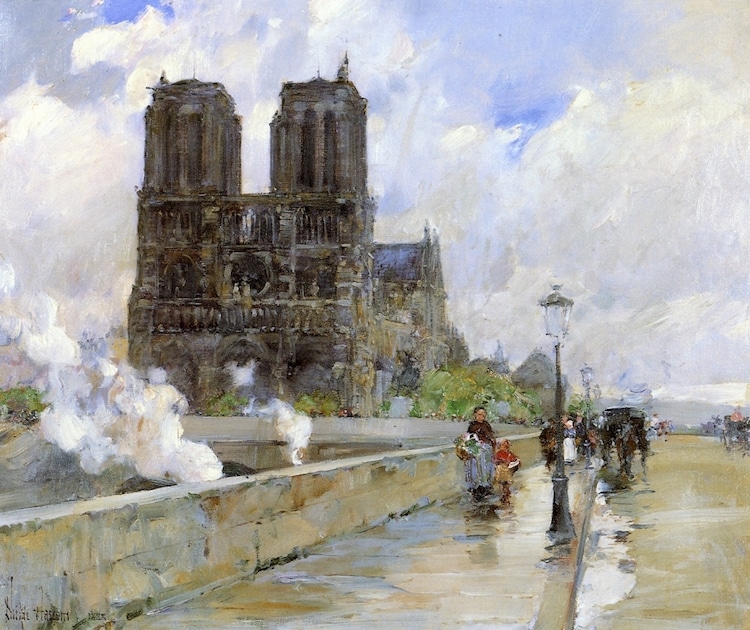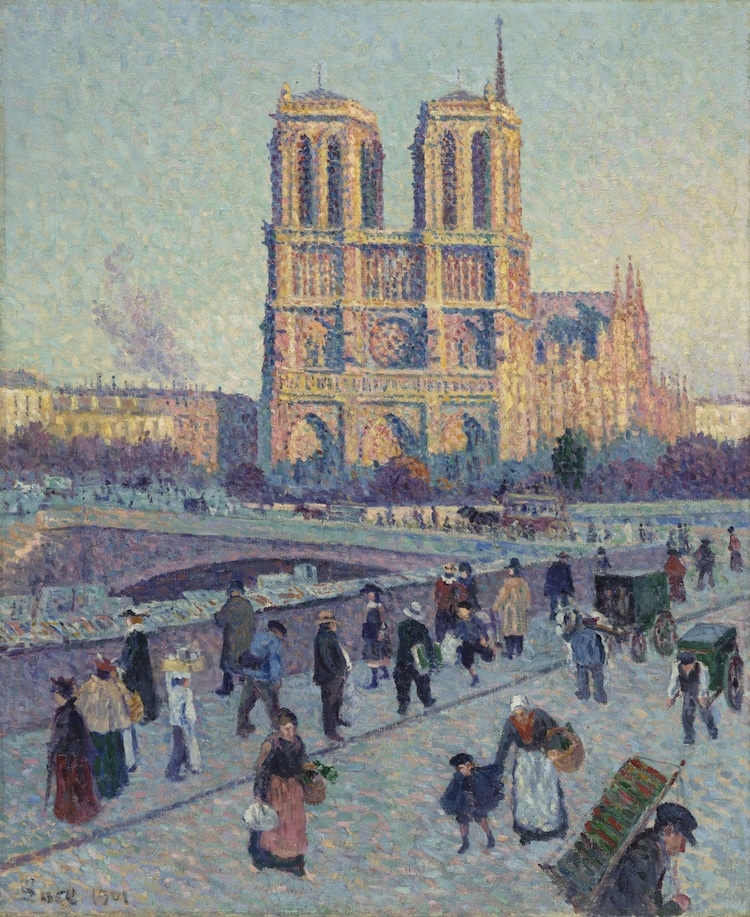Notre Dame De Paris Was Built During Which Major Art Period?

Notre-Dame Cathedral is one of Paris' most important monuments. Completed with much fanfare in the middle of the 14th century, the fantastic Medieval cathedral has served several purposes during its 850-year history.
Every bit the seat of the city'southward archbishop, Notre-Dame is Paris' premier Catholic Church. However, equally a gem of Gothic architecture famous for its sky-loftier stature, enchanting collection of gargoyles, and beautiful rose windows, the cathedral'due south cultural significance transcends religion—making it a perfect muse for all kinds of creatives.
Here, we take a expect at some of the artists who accept turned to the cathedral for inspiration, from a manuscript illuminator who worked during the Middle Ages to 1 of the world'due south most famous mod artists.
Jean Fouquet, a Chief of Miniature Manuscripts
In medieval Europe, artists by and large employed religious iconography in their work, which materialized every bit three fine art forms: altarpieces, panel paintings, and illuminated manuscripts. Jean Fouquet, a 15th-century French artist, mastered all three, making him one of the Eye Ages' most preeminent painters.
Fouquet is known for his attending to detail—a skill that is particularly evident in The Right Hand of God Protecting the True-blue against the Demons. Measuring merely over 7 by 5 inches, this excerpt from the miniatureHours of Étienne Chevalier shows a "topographically authentic delineation of medieval Paris" dominated by a and then-115-twelvemonth-old Notre-Dame Cathedral.
Israel Silvestre, a Royal Engraver
In the 17th century, Israel Silvestreserved equally the draftsman and engraver of the French rex. Based in a workshop in the Louvre, one of Silvestre'south royal duties was to document sites in and around Paris.
Past the time he died, his body of work included over 1,000 engravings. While virtually of these pieces showcase views of the Palace of Versailles and other regal areas, Notre-Matriarch Cathedral likewise made an advent on more than i occasion.
Jacques-Louis David, a Pioneer of Neo-Classical Painting

Jacques-Louis David, "Coronation of Napoleon Bonaparte," 1805-1807 (Photograph: Wikimedia Commons Public Domain)
Though the majority of artists featured Notre-Dame'south famous façade in their work, Jacques-Louis David found inspiration within its walls. InCoronation of Napoleon Bonaparte, a large-scale painting from the Neo-Classical period, David documents 1 of the cathedral's many important events: Napoleon's sacred crowning.
Deputed by Napoleon himself, the piece showcases the lavish nature of this over-the-pinnacle ceremony, which was intended to commemorate the military leader's transformation into a God-sent emperor of France.
Childe Hassam, a Boston-Born Impressionist

Childe Hassam, "Notre Matriarch Cathedral, Paris," 1888 (Photo: Wikimedia Commons Public Domain)
In the 19th century, Impressionism emerged in Paris. With a focus on capturing fleeting "impressions" of their surroundings, Impressionist artists often documented daily life in their paintings. While many of the works produced during this time are set in the idyllic French countryside, American Impressionist and gorging traveler Childe Hassam frequently looked to metropolis life for inspiration, culminating in lively paintings likeNotre Matriarch Cathedral, Paris.
Maximilien Luce, a Parisian Pointillist

Maximilien Luce, "The Quai Saint-Michel and Notre-Matriarch," 1901 (Photo: Wikimedia Commons Public Domain)
Pointillism, a style of painting characterized by small-scale, colorful dots, made its chiliad debut in 1886. While the motion is nigh famously associated with pioneers Georges Seurat and Paul Signac, they are not the only artists who mastered the technique.
Maximilien Luce, for example, excelled equally a Pointillist. The Paris-based painter's eye for particular and cohesive employ of color is especially evident in his Notre-Dame series, comprising works likeThe Quai Saint-Michel and Notre-Dame and Notre-Dame de Paris—Luce's highest-selling painting to date.
Henri Matisse, a Major Modernist

Henri Matisse, "A Glimpse of Notre Dame in the Late Afternoon," 1902 (Photograph: Wikimedia Commons Public Domain)
At the turn of the 20th century, modern art principalHenri Matisse produced several paintings of Notre-Dame Cathedral—a landmark he was lucky plenty to meet from his Parisian studio. His depictions of the church and the surrounding quay vary in fashion, including an Impressionist rendition, an avant-garden abstraction, and the Cézanne-esque Glimpse of Notre Dame in the Late Afternoon.
Edward Hopper, an American Icon
The majority of paintings by lifelong New Yorker Edward Hopper explore the reality of modern life in the major American metropolis. However, early in his career, Hopper found inspiration in Paris, a city he described every bit "most too formal and sweet to the taste after the raw disorder of New York" ( Edward Hopper: An Intimate Biography).
His idyllic perception of Paris is evident in Notre Dame de Paris and other paintings produced betwixt 1906 and 1910—a flow in which he fabricated several trips to the French capital.
Pablo Picasso, a Modern Main
Though born in Spain, Pablo Picasso spent nigh of his 79-year career in French republic. Like many of his modernist peers, he split his time betwixt the sun-soaked South of France and Paris, where he paintedNotre-Dame de Parisin 1954.
Painted afterwards in Picasso's career, Notre-Dame de Paris showcases his skillful approach to mural painting, an involvement evident in his early work. As this genre "played an integral role in Picasso's development equally an creative person," Notre-Dame de Paris, ultimately, serves as a subtle and symbolic homage to his artistic beginnings.
Related Articles:
Artists Pay Tribute to Paris' Iconic Notre-Dame Cathedral After Devastating Fire
8 Iconic Artists and the Inspiration Behind Their Favorite Subjects
7 Medieval European Sites You Can Actually Visit Today
salernocamprow1974.blogspot.com
Source: https://mymodernmet.com/notre-dame-art/
0 Response to "Notre Dame De Paris Was Built During Which Major Art Period?"
Post a Comment